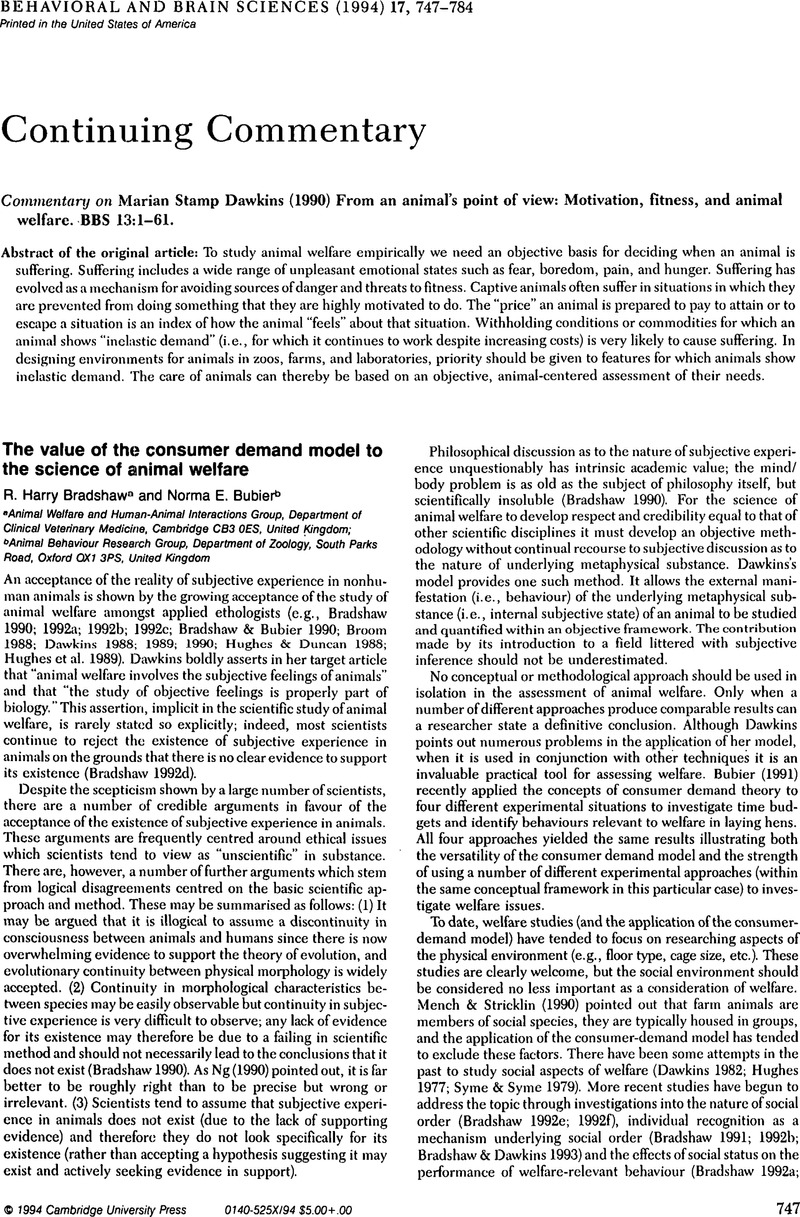No CrossRef data available.
Article contents
How to argue with egg producers
Review products
Commentary onDawkinsMarian Stamp (1990) From an animal's point of view: Motivation, fitness, and animal welfare. BBS 13:1–61.
Published online by Cambridge University Press: 04 February 2010
Abstract
An abstract is not available for this content so a preview has been provided. Please use the Get access link above for information on how to access this content.

- Type
- Reply
- Information
- Copyright
- Copyright © Cambridge University Press 1994
References
Bekoff, M. (1992) The animal's point of view, animal welfare and some other related matters. Behavioral and Brain Sciences 14:753–55. [RHB]Google Scholar
Bradshaw, R. H. (1990) The science of animal welfare and the subjective experience of animals. Applied Animal Behaviour Science 26:191–93. [RHB[Google Scholar
Bradshaw, R. H. (1991) Discrimination of group members by laying hens. Behavioural Processes 24:143–51. [RHB]Google Scholar
Bradshaw, R. H. (1992a) Effects of social status on the performance of non-interactive behaviours in small groups of laying hens. Applied Animal Behaviour Science 33:77–81. [RHB]Google Scholar
Bradshaw, R. H. (1992b) Conspecific discrimination and social preference in laying hens. Applied Animal Behaviour Science 33:69–75. [RHB]Google Scholar
Bradshaw, R. H. (1992c) Describing social order in laying hens. Journal of the World Pheasant Association 15:81–92. [RHB]Google Scholar
Bradshaw, R. H. (1992d) The science of animal welfare and the law of parsimony. Applied Animal Behaviour Science 33:287–88. [RHB]Google Scholar
Bradshaw, R. H. (1992e) The expression of agonistic behaviour in groups of laying hens: A regression analysis. Applied Animal Behaviour Science 33:63–68. [RHB]Google Scholar
Bradshaw, R. H. (1992f) Individual attributes as predictors of social status in small groups of laying hens. Applied Animal Behaviour Science 34:359–63. [RHB]Google Scholar
Bradshaw, R. H. & Bubier, N. E. (1990) The effect of spatial restriction on the duration and frequency of wing-flapping, in the laying hen. Applied Animal Behaviour Science 28:298. [RHB]Google Scholar
Bradshaw, R. H. & Dawkins, M. S. (1993) Slides of conspecifics as representatives of real animals in laying hens (Callus domesticus). Behavioural Processes 28:165–72. [RHB]Google Scholar
Broom, D. M. (1986) Indicators of poor welfare. British Veterinary Journal 142:524–26. [MKW]Google Scholar
Broom, D. M. (1988) The scientific assessment of welfare. Applied Animal Behaviour Science 20:5–19. [RHB]Google Scholar
Bubier, N. E. (1991) The behavioral priorities of laying hens. D.Phil. Thesis, Univerity of Oxford. [RHB].Google Scholar
Collias, N. E. & Collias, E. C. (1967) A field study of the red jungle fowl in North-Central India. Condor 69:360–86. [MKW[Google Scholar
Dawkins, M. S. (1982) Elusive concept of preferred group size in domestic hens.
Applied Animal Ethology 8:365–75. [RHB]Google Scholar
Dawkins, M. S. (1988) Behavioural deprivation: A central problem in animal welfare. Applied Animal Behaviour Science 20:209–25. [RHB]Google Scholar
Dawkins, M. S. (1989) Time budgets in red jungle fowl as a baseline for the assessment of welfare in domestic fowl. Applied Animal Behaviour Science 24:77–80. [RHB]Google Scholar
Dawkins, M. S. (1990) From an animal's point of view: Motivation, fitness, and animal welfare. Behavioral and Brain Sciences 13:1–61. [rPS, RHB, MKW]Google Scholar
Fox, M. W. (1968) Socialization, environmental factors, and abnormal behavioural development in animals. In: Abnormal behavior in animals, ed. Fox, M. W.. Saunders. [MKW]Google Scholar
Hughes, B. O. (1977) Selection of group size by individual laying hens. British Poultry Science 18:9–18. [RHB]Google Scholar
Hughes, B. O. & Duncan, I. J. H. (1988) The notion of ethological “need”: Models of motivation and animal welfare. Animal Behaviour 36:1696–1707. [RHB]Google Scholar
Hughes, B. O., Duncan, I. J. H. & Brown, M. F. (1989) The performance of nest-building by domestic hens: Is it more important than the construction of a nest? Animal Behaviour 37:210–14. [RHB]Google Scholar
Hutt, C. & Hutt, S. J. (1965) Effect of environmental complexity on stereotyped behaviors of children. Animal Behaviour 12:1–4. [MKW]Google Scholar
Kiley-Worthington, M. (1977) The behavioural problems of farm animals. Oriel Press. [MKW]Google Scholar
Kiley-Worthington, M. (1990a) Animals in circuses and zoos. Chiron's world? Little Eco-farm Publications. [MKW]Google Scholar
Kiley-Worthington, M. (1990b) Ecological, ethological and ethically sound environments for animals: Towards symbiosis? Agricultural Ethics 2:323–47. [MKW]Google Scholar
Mench, J. A. & Stricklin, W. R. (1990) Consumer demand theory and social behaviour: All chickens are not equal. Behavioral and Brain Sciences 13:28. [RHB]Google Scholar
Meyer-Holzapfel, M. (1968) Abnormal behavior in zoo animals. In: Abnormal behavior in animals, ed. Fox, M. W.. Saunders. [MKW]Google Scholar
Ng, Y.-K. (1990) The case for and difficulties in using “demand areas” to measure changes in well-being. Behavioral and Brain Sciences 13:30–31. [RHB]Google Scholar
Nicol, C. J. (1989) Social influences on the comfort behaviour of laying hens. Applied Animal Behaviour Science 22:75–81. [RHB]Google Scholar
Singer, P. (1990b) The significance of animal suffering. Behavioral and Brain Sciences 13(1):9–12. [MKW]Google Scholar
Singer, P. (1990c) Ethics and animals. Behavioral and Brain Sciences 13(1):45–49. [MKW]Google Scholar
Thorpe, W. (1965) The assessment of pain and distress in animals. In: Report of the technical committee to the enquiry into the welfare of animals kept under intensive livestock systems. F. W. R. Brambell (Chairman). Her Majesty's Stationery Office, London. [MKW] 'Google Scholar
Trunkfield, H. R. & Broom, D. M. (1991) The effects of the social environment on calf responses to handling and transport. Applied Animal Behaviour Science 30:177. [RHB]Google Scholar


